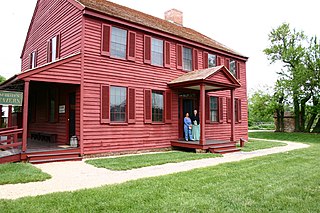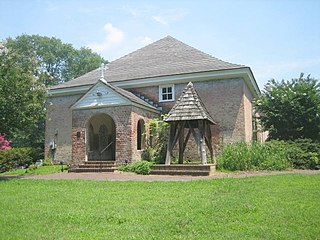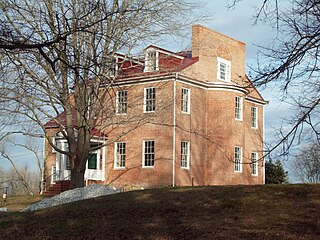
Clinton is an unincorporated census-designated place (CDP) in Prince George's County, Maryland, United States. Clinton was formerly known as Surrattsville until after the time of the Civil War. The population of Clinton was 38,760 at the 2020 census. Clinton is historically known for its role in the American Civil War concerning the Abraham Lincoln assassination. Clinton is adjacent to Camp Springs, Rosaryville, Melwood, and Andrews Air Force Base.

Benjamin Contee was an American Episcopal priest and statesman from Maryland. He was an officer in the American Revolutionary War, a delegate to the Confederation Congress, and member of the first United States House of Representatives.

William Smallwood was an American planter, soldier and politician from Charles County, Maryland. He served in the American Revolutionary War, rising to the rank of major general. He was serving as the fourth Governor of Maryland when the state adopted the United States Constitution.

Piscataway is an unincorporated community in Prince George's County, Maryland, United States. It is one of the oldest European-colonized communities in the state. The Piscataway Creek provided sea transportation for export of tobacco. It is located near the prior Piscataway tribe village of Kittamaqundi.

Maryland Route 223 is a state highway in the U.S. state of Maryland. The state highway runs 12.65 miles (20.36 km) from a dead end near Livingston Road in Piscataway north to Mellwood Road in Melwood. MD 223 passes through suburban areas of southern Prince George's County, including the community of Woodyard south of Andrews Air Force Base between MD 5 in Clinton and MD 4 in Melwood. The highway was constructed from Clinton to near Piscataway in the 1920s and early 1930s. MD 223 was extended west to Livingston Road in Piscataway and east to MD 4 in the mid-1950s. MD 223's interchanges with MD 4 and MD 5 were built in the mid-1960s and early 1990s, respectively.

Lieutenant-General Josias Fendall, Esq., was the 4th Proprietary Governor of Maryland. He was born in England, and came to the Province of Maryland. He was the progenitor of the Fendall family in America.

The Lee–Fendall House is a historic house museum and garden located in Old Town Alexandria, Virginia at 614 Oronoco Street. Since its construction in 1785 the house has served as home to thirty-seven members of the Lee family (1785–1903), hundreds of convalescing Union soldiers (1863–1865), the prominent Downham family (1903–1937), the family of powerful labor leader John L. Lewis (1937–1969), and enslaved or free servants of those families.
Thomas Contee of "Brookefield", near Nottingham, Prince George's County, Maryland, was an American patriot who held the rank of colonel, militia man, politician, planter.

Col. Charles Ridgely II, "Charles The Merchant" (1702–1772), of "Ridgely's Whim", was a Justice, planter, merchant, ironmaster, and member of the General Assembly of Maryland's lower chamber, House of Delegates and one of Baltimore County's commissioners. Charles II was the son of Charles Ridgely I,, , and Deborah Dorsey.
Walter Brooke Cox Worthington was a member of the Maryland House of Delegates.
Hon. William Grafton Delaney Worthington IV (1785–1856) was an American lawyer, judge and state Governor, and Secretary of the Territory of East Florida.

Located south of Laurel in Prince George's County, Maryland, United States, Montpelier Mansion is a five-part, Georgian style plantation house most likely constructed between 1781 and 1785. It has also been known as the Snowden-Long House, New Birmingham, or simply Montpelier. Built by Major Thomas Snowden and his wife Anne, the house is now a National Historic Landmark operated as a house museum. The home and 70 acres (28 ha) remain of what was once a slave plantation of about 9,000 acres (3,600 ha).

Accokeek Creek Site, also known as Moyaone, is an archaeological site in Prince George's County, Maryland, located along the Potomac River across from Mount Vernon in today's Piscataway Park, which was inhabited intermittently since 2000 BC. Accokeek Creek Site was declared a National Historic Landmark in 1964.

His Lordship's Kindness, also known as Poplar Hill, is a historic plantation estate on Woodyard Road east of Clinton, Maryland. It was built in the 1780s for Prince George's County planter Robert Darnall. The five-part Georgian mansion retains a number of subsidiary buildings including a slave's hospital and a dovecote. The property is now operated as a museum by a local nonprofit preservation group. It was designated a National Historic Landmark in 1970.
The Fendall-Dent-Worthington family is a family of politicians from the United States. Below is a list of members:

"St. John's Church", "St. John's Episcopal Church", or "St. John's Episcopal Church, Broad Creek", is a historic Episcopal church located at 9801 Livingston Road in Fort Washington, Prince George's County, Maryland. It is a rectangular Flemish bond brick structure with a bell hipped roof. The interior features a barrel vaulted ceiling with an intricate support system.

Ashland is a historic home located in Upper Marlboro, Prince George's County, Maryland, United States. It is a 2+1⁄2-story, hip-roofed frame dwelling with fine Victorian Italianate decorative detail. It was built in 1866-1867 by William Beanes Hill of Compton Bassett for his son, William Murdock Hill. The house has been continuously associated with the prominent Hill family. Ashland is one of only a few significant frame dwellings of the Italianate style which survive in the county. It has a simple square floor plan, with cross gables in each plane of the hip roof. Also on the property are historic outbuildings.

Melford is a historic plantation house located on the grounds of the Maryland Science and Technology Center, near the intersection of U.S. Route 301 and U.S. Route 50, at Bowie, Prince George's County, Maryland. The house is multi-part, gable-roofed, brick and stone dwelling house constructed probably in the mid-late 1840s, with elements of the Greek Revival style.

Philip Richard Fendall I (1734–1805) was an influential banker, lawyer, and merchant in Alexandria, Virginia. He was a member of the Lee family and a friend and business partner to George Washington. Fendall constructed the Lee-Fendall House on the corner of Washington and Oronoco Streets as a lasting home for his family.
William Luke Marbury Jr. was a prominent 20th-century American lawyer who practiced with his family's law firm of Marbury, Miller & Evans. He was known to be a childhood friend of alleged Soviet spy Alger Hiss.



















